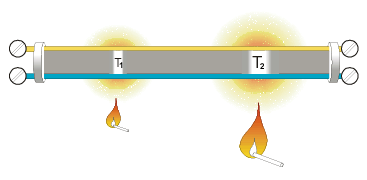|
|||||||||||||||
| Xco -> Continuous Thermocouples -> What is a Continuous Thermocouple? |
WHAT is a CONTINUOUS THERMOCOUPLE?The Continuous Thermocouple is designed to sense temperature increases in areas too large (or important) to be covered by multiples of typical temperature sensors (e.g. standard thermocouples or RTD's). In order to understand the operation of a Continuous Thermocouple, it is important to understand the theory which made the development of these unique temperature sensors possible. CT²C have the same operating characteristics and detect the hottest temperature existing along their entire length. It is also important to understand the difference between Continuous Thermocouples and other Linear Heat Detectors. A detailed comparison is provided on our Sensor Comparison page. Seebeck EffectContinuous Thermocouple function is based on the long-established "Seebeck Effect", where a circuit formed from two dissimilar wires joined at both ends, develops an emf (voltage) proportional to the difference in the two junction temperatures. Today these junctions are referred to as the measuring junction, and the reference junction. Standard thermocoupleIn common practice the wires are joined at one end only to form a point-type temperature sensor known as a "Thermocouple". Instrumentation converts the mV (millivolt) analog signal to a related temperature in degrees F or C. Continuous ThermocoupleContinuous Thermocouples generate a measurable voltage like normal thermocouples, however, the measuring junction in a Continuous Thermocouple is not formed by directly joining the two wires. More remarkably, the measuring junction is not fixed but, when subjected to an increase in temperature, becomes concentrated at the hottest point anywhere along the sensor's entire length. This is due to the large fall in resistance in the insulating material at the heated area.The nature of this insulating material is such that the voltage developed between the two wires always relates to the highest temperature along the cable's length. This is true if the "hot spot" is fixed, as well as if the "hot spot" is moving along the length of the sensor. This phenomenon allows for an infinite number of measuring points along the sensors length.    |